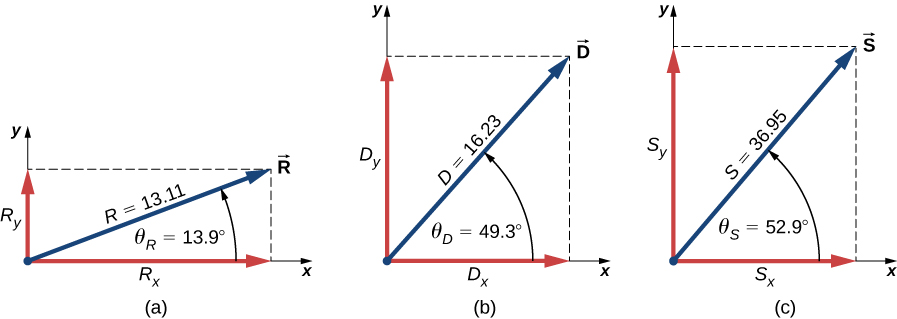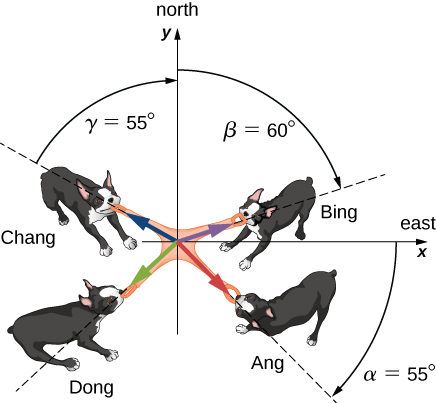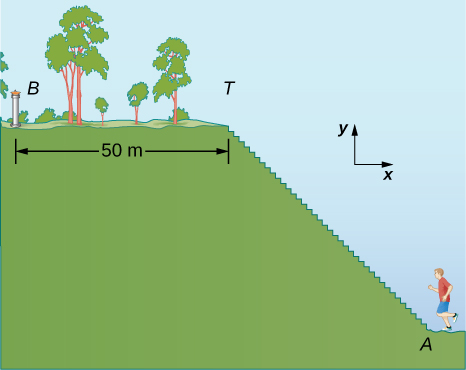2.3: Algebra of Vectors
Learning Objectives
By the end of this section, you will be able to:
- Apply analytical methods of vector algebra to find resultant vectors and to solve vector equations for unknown vectors.
- Interpret physical situations in terms of vector expressions.
Vectors can be added together and multiplied by scalars. Vector addition is associative and commutative, and vector multiplication by a sum of scalars is distributive. Also, scalar multiplication by a sum of vectors is distributive:
In this equation, [latex]\alpha[/latex] is any number (a scalar). For example, a vector antiparallel to vector [latex]\stackrel{\to }{A}={A}_{x}\hat{i}+{A}_{y}\hat{j}+{A}_{z}\hat{k}[/latex] can be expressed simply by multiplying [latex]\stackrel{\to }{A}[/latex] by the scalar [latex]\alpha =-1[/latex]:
Direction of Motion
In a Cartesian coordinate system where [latex]\hat{i}[/latex] denotes geographic east, [latex]\hat{j}[/latex] denotes geographic north, and [latex]\hat{k}[/latex] denotes altitude above sea level, a military convoy advances its position through unknown territory with velocity [latex]\stackrel{\to }{v}=(4.0\hat{i}+3.0\hat{j}+0.1\hat{k})\text{km}\text{/}\text{h}[/latex]. If the convoy had to retreat, in what geographic direction would it be moving?
Solution
The velocity vector has the third component [latex]{\stackrel{\to }{v}}_{z}=(+0.1\text{km}\text{/}\text{h})\hat{k}[/latex], which says the convoy is climbing at a rate of 100 m/h through mountainous terrain. At the same time, its velocity is 4.0 km/h to the east and 3.0 km/h to the north, so it moves on the ground in direction [latex]{\text{tan}}^{-1}(3\phantom{\rule{0.2em}{0ex}}\text{/}4\\approx 37\text{°}[/latex] north of east. If the convoy had to retreat, its new velocity vector [latex]\stackrel{\to }{u}[/latex] would have to be antiparallel to [latex]\stackrel{\to }{v}[/latex] and be in the form [latex]\stackrel{\to }{u}=\text{−}\alpha \stackrel{\to }{v}[/latex], where [latex]\alpha[/latex] is a positive number. Thus, the velocity of the retreat would be [latex]\stackrel{\to }{u}=\alpha(-4.0\hat{i}-3.0\hat{j}-0.1\hat{k})\text{km}\text{/}\text{h}[/latex]. The negative sign of the third component indicates the convoy would be descending. The direction angle of the retreat velocity is [latex]{\text{tan}}^{-1}(-3\alpha \text{/}-4\alpha )\approx 37\text{°}[/latex] south of west. Therefore, the convoy would be moving on the ground in direction [latex]37\text{°}[/latex] south of west while descending on its way back.
The generalization of the number zero to vector algebra is called the null vector, denoted by [latex]\stackrel{\to }{0}[/latex]. All components of the null vector are zero, [latex]\stackrel{\to }{0}=0\hat{i}+0\hat{j}+0\hat{k}[/latex], so the null vector has no length and no direction.
Two vectors [latex]\stackrel{\to }{A}[/latex] and [latex]\stackrel{\to }{B}[/latex] are equal vectors if and only if their difference is the null vector:
This vector equation means we must have simultaneously [latex]{A}_{x}-{B}_{x}=0[/latex], [latex]{A}_{y}-{B}_{y}=0[/latex], and [latex]{A}_{z}-{B}_{z}=0[/latex]. Hence, we can write [latex]\stackrel{\to }{A}=\stackrel{\to }{B}[/latex] if and only if the corresponding components of vectors [latex]\stackrel{\to }{A}[/latex] and [latex]\stackrel{\to }{B}[/latex] are equal:
Two vectors are equal when their corresponding scalar components are equal.
Resolving vectors into their scalar components (i.e., finding their scalar components) and expressing them analytically in vector component form allows us to use vector algebra to find sums or differences of many vectors analytically (i.e., without using graphical methods). For example, to find the resultant of two vectors [latex]\stackrel{\to }{A}[/latex] and [latex]\stackrel{\to }{B}[/latex], we simply add them component by component, as follows:
In this way, using (Figure), scalar components of the resultant vector [latex]\stackrel{\to }{R}={R}_{x}\hat{i}+{R}_{y}\hat{j}+{R}_{z}\hat{k}[/latex] are the sums of corresponding scalar components of vectors [latex]\stackrel{\to }{A}[/latex] and [latex]\stackrel{\to }{B}[/latex]:
Analytical methods can be used to find components of a resultant of many vectors. For example, if we are to sum up [latex]N[/latex] vectors [latex]{\stackrel{\to }{F}}_{1},{\stackrel{\to }{F}}_{2},{\stackrel{\to }{F}}_{3},\dots ,{\stackrel{\to }{F}}_{N}[/latex], where each vector is [latex]{\stackrel{\to }{F}}_{k}={F}_{kx}\hat{i}+{F}_{ky}\hat{j}+{F}_{kz}\hat{k}[/latex], the resultant vector [latex]{\stackrel{\to }{F}}_{R}[/latex] is
Therefore, scalar components of the resultant vector are
Having found the scalar components, we can write the resultant in vector component form:
Analytical methods for finding the resultant and, in general, for solving vector equations are very important in physics because many physical quantities are vectors. For example, we use this method in kinematics to find resultant displacement vectors and resultant velocity vectors, in mechanics to find resultant force vectors and the resultants of many derived vector quantities, and in electricity and magnetism to find resultant electric or magnetic vector fields.
Analytical Computation of a Resultant
Three displacement vectors [latex]\stackrel{\to }{A}[/latex], [latex]\stackrel{\to }{B}[/latex], and [latex]\stackrel{\to }{C}[/latex] in a plane ((Figure)) are specified by their magnitudes A = 10.0, B = 7.0, and C = 8.0, respectively, and by their respective direction angles with the horizontal direction [latex]\alpha =35\text{°},[/latex] [latex]\beta =-110\text{°}[/latex], and [latex]\gamma =30\text{°}[/latex]. The physical units of the magnitudes are centimeters. Resolve the vectors to their scalar components and find the following vector sums: (a) [latex]\stackrel{\to }{R}=\stackrel{\to }{A}+\stackrel{\to }{B}+\stackrel{\to }{C}[/latex], (b) [latex]\stackrel{\to }{D}=\stackrel{\to }{A}-\stackrel{\to }{B}[/latex], and (c) [latex]\stackrel{\to }{S}=\stackrel{\to }{A}-3\stackrel{\to }{B}+\stackrel{\to }{C}[/latex].
Strategy
First, we use (Figure) to find the scalar components of each vector and then we express each vector in its vector component form given by (Figure). Then, we use analytical methods of vector algebra to find the resultants.
Solution
We resolve the given vectors to their scalar components:

Check Your Understanding 2.8
Three displacement vectors [latex]\stackrel{\to }{A}[/latex], [latex]\stackrel{\to }{B}[/latex], and [latex]\stackrel{\to }{F}[/latex] ((Figure)) are specified by their magnitudes A = 10.00, B = 7.00, and F = 20.00, respectively, and by their respective direction angles with the horizontal direction [latex]\alpha =35\text{°}[/latex], [latex]\beta =-110\text{°}[/latex], and [latex]\phi =110\text{°}[/latex]. The physical units of the magnitudes are centimeters. Use the analytical method to find vector [latex]\stackrel{\to }{G}=\stackrel{\to }{A}+2\stackrel{\to }{B}-\stackrel{\to }{F}[/latex]. Verify that
G = 28.15 cm and that [latex]{\theta }_{G}=-68.65\text{°}[/latex].
The Tug-of-War Game
Four dogs named Ang, Bing, Chang, and Dong play a tug-of-war game with a toy ((Figure)). Ang pulls on the toy in direction [latex]\alpha =55\text{°}[/latex] south of east, Bing pulls in direction [latex]\beta =60\text{°}[/latex] east of north, and Chang pulls in direction [latex]\gamma =55\text{°}[/latex] west of north. Ang pulls strongly with 160.0 units of force (N), which we abbreviate as A = 160.0 N. Bing pulls even stronger than Ang with a force of magnitude B = 200.0 N, and Chang pulls with a force of magnitude C = 140.0 N. When Dong pulls on the toy in such a way that his force balances out the resultant of the other three forces, the toy does not move in any direction. With how big a force and in what direction must Dong pull on the toy for this to happen?

Strategy
We assume that east is the direction of the positive x-axis and north is the direction of the positive y-axis. As in (Figure), we have to resolve the three given forces— [latex]\stackrel{\to }{A}[/latex] (the pull from Ang), [latex]\stackrel{\to }{B}[/latex] (the pull from Bing), and [latex]\stackrel{\to }{C}[/latex] (the pull from Chang)—into their scalar components and then find the scalar components of the resultant vector [latex]\stackrel{\to }{R}=\stackrel{\to }{A}+\stackrel{\to }{B}+\stackrel{\to }{C}[/latex]. When the pulling force [latex]\stackrel{\to }{D}[/latex] from Dong balances out this resultant, the sum of [latex]\stackrel{\to }{D}[/latex] and [latex]\stackrel{\to }{R}[/latex] must give the null vector [latex]\stackrel{\to }{D}+\stackrel{\to }{R}=\stackrel{\to }{0}[/latex]. This means that [latex]\stackrel{\to }{D}=\text{−}\stackrel{\to }{R}[/latex], so the pull from Dong must be antiparallel to [latex]\stackrel{\to }{R}[/latex].
Solution
The direction angles are [latex]{\theta }_{A}=\text{−}\alpha =-55\text{°}[/latex], [latex]{\theta }_{B}=90\text{°}-\beta =30\text{°}[/latex], and [latex]{\theta }_{C}=90\text{°}+\gamma =145\text{°}[/latex], and substituting them into (Figure) gives the scalar components of the three given forces:
Now we compute scalar components of the resultant vector [latex]\stackrel{\to }{R}=\stackrel{\to }{A}+\stackrel{\to }{B}+\stackrel{\to }{C}[/latex]:
The antiparallel vector to the resultant [latex]\stackrel{\to }{R}[/latex] is
The magnitude of Dong’s pulling force is
The direction of Dong’s pulling force is
Dong pulls in the direction [latex]18.1\text{°}[/latex] south of west because both components are negative, which means the pull vector lies in the third quadrant ((Figure)).
Check Your Understanding 2.9
Suppose that Bing in (Figure) leaves the game to attend to more important matters, but Ang, Chang, and Dong continue playing. Ang and Chang’s pull on the toy does not change, but Dong runs around and bites on the toy in a different place. With how big a force and in what direction must Dong pull on the toy now to balance out the combined pulls from Chang and Ang? Illustrate this situation by drawing a vector diagram indicating all forces involved.
Vector Algebra
Find the magnitude of the vector [latex]\stackrel{\to }{C}[/latex] that satisfies the equation [latex]2\stackrel{\to }{A}-6\stackrel{\to }{B}+3\stackrel{\to }{C}=2\hat{j}[/latex], where [latex]\stackrel{\to }{A}=\hat{i}-2\hat{k}[/latex] and [latex]\stackrel{\to }{B}=\text{−}\hat{j}+\hat{k}\text{/}2[/latex].
Strategy
We first solve the given equation for the unknown vector [latex]\stackrel{\to }{C}[/latex]. Then we substitute [latex]\stackrel{\to }{A}[/latex] and [latex]\stackrel{\to }{B}[/latex]; group the terms along each of the three directions [latex]\hat{i}[/latex], [latex]\hat{j}[/latex], and [latex]\hat{k}[/latex]; and identify the scalar components [latex]{C}_{x}[/latex], [latex]{C}_{y}[/latex], and [latex]{C}_{z}[/latex]. Finally, we substitute into (Figure) to find magnitude C.
Solution
The components are [latex]{C}_{x}=\text{−}2\phantom{\rule{0.2em}{0ex}}\text{/}3[/latex], [latex]{C}_{y}=-4\text{/}3[/latex], and [latex]{C}_{z}=7\phantom{\rule{0.2em}{0ex}}\text{/}3[/latex], and substituting into (Figure) gives
Displacement of a Skier
Starting at a ski lodge, a cross-country skier goes 5.0 km north, then 3.0 km west, and finally 4.0 km southwest before taking a rest. Find his total displacement vector relative to the lodge when he is at the rest point. How far and in what direction must he ski from the rest point to return directly to the lodge?
Strategy
We assume a rectangular coordinate system with the origin at the ski lodge and with the unit vector [latex]\hat{i}[/latex] pointing east and the unit vector [latex]\hat{j}[/latex] pointing north. There are three displacements: [latex]{\stackrel{\to }{D}}_{1}[/latex], [latex]{\stackrel{\to }{D}}_{2}[/latex], and [latex]{\stackrel{\to }{D}}_{3}[/latex]. We identify their magnitudes as [latex]{D}_{1}=5.0\phantom{\rule{0.2em}{0ex}}\text{km}[/latex], [latex]{D}_{2}=3.0\phantom{\rule{0.2em}{0ex}}\text{km}[/latex], and [latex]{D}_{3}=4.0\phantom{\rule{0.2em}{0ex}}\text{km}[/latex]. We identify their directions are the angles [latex]{\theta }_{1}=90\text{°}[/latex], [latex]{\theta }_{2}=180\text{°}[/latex], and [latex]{\theta }_{3}=180\text{°}+45\text{°}=225\text{°}[/latex]. We resolve each displacement vector to its scalar components and substitute the components into (Figure) to obtain the scalar components of the resultant displacement [latex]\stackrel{\to }{D}[/latex] from the lodge to the rest point. On the way back from the rest point to the lodge, the displacement is [latex]\stackrel{\to }{B}=\text{−}\stackrel{\to }{D}[/latex]. Finally, we find the magnitude and direction of [latex]\stackrel{\to }{B}[/latex].
Solution
Scalar components of the displacement vectors are
Scalar components of the net displacement vector are
Hence, the skier’s net displacement vector is [latex]\stackrel{\to }{D}={D}_{x}\hat{i}+{D}_{y}\hat{j}=(-5.8hat{i}+2.2\hat{j})\text{km}[/latex]. On the way back to the lodge, his displacement is [latex]\stackrel{\to }{B}=\text{−}\stackrel{\to }{D}=\text{−}(-5.8\hat{i}+2.2\hat{j})\text{km}=(5.8\hat{i}-2.2\hat{j})\text{km}[/latex]. Its magnitude is [latex]B=\sqrt{{B}_{x}^{2}+{B}_{y}^{2}}=\sqrt{{(5.8)}^{2}+{(-2.2)}^{2}}\phantom{\rule{0.2em}{0ex}}\text{km}=6.2\phantom{\rule{0.2em}{0ex}}\text{km}[/latex] and its direction angle is [latex]\theta ={\text{tan}}^{-1}(-2.2\text{/}5.8)=-20.8\text{°}[/latex]. Therefore, to return to the lodge, he must go 6.2 km in a direction about [latex]21\text{°}[/latex] south of east.
Significance
Notice that no figure is needed to solve this problem by the analytical method. Figures are required when using a graphical method; however, we can check if our solution makes sense by sketching it, which is a useful final step in solving any vector problem.
Displacement of a Jogger
A jogger runs up a flight of 200 identical steps to the top of a hill and then runs along the top of the hill 50.0 m before he stops at a drinking fountain ((Figure)). His displacement vector from point A at the bottom of the steps to point B at the fountain is [latex]{\stackrel{\to }{D}}_{AB}=(-90.0\hat{i}+30.0\hat{j})\text{m}[/latex]. What is the height and width of each step in the flight? What is the actual distance the jogger covers? If he makes a loop and returns to point A, what is his net displacement vector?

Strategy
The displacement vector [latex]{\stackrel{\to }{D}}_{AB}[/latex] is the vector sum of the jogger’s displacement vector [latex]{\stackrel{\to }{D}}_{AT}[/latex] along the stairs (from point A at the bottom of the stairs to point T at the top of the stairs) and his displacement vector [latex]{\stackrel{\to }{D}}_{TB}[/latex] on the top of the hill (from point T at the top of the stairs to the fountain at point B). We must find the horizontal and the vertical components of [latex]{\stackrel{\to }{D}}_{TB}[/latex]. If each step has width w and height h, the horizontal component of [latex]{\stackrel{\to }{D}}_{TB}[/latex] must have a length of 200w and the vertical component must have a length of 200h. The actual distance the jogger covers is the sum of the distance he runs up the stairs and the distance of 50.0 m that he runs along the top of the hill.
Solution
In the coordinate system indicated in (Figure), the jogger’s displacement vector on the top of the hill is [latex]{\stackrel{\to }{D}}_{TB}=\left(-50.0\phantom{\rule{0.2em}{0ex}}\text{m}\right)\hat{i}[/latex]. His net displacement vector is
Therefore, his displacement vector [latex]{\stackrel{\to }{D}}_{TB}[/latex] along the stairs is
Its scalar components are [latex]{D}_{ATx}=-40.0\phantom{\rule{0.2em}{0ex}}\text{m}[/latex] and [latex]{D}_{ATy}=30.0\phantom{\rule{0.2em}{0ex}}\text{m}[/latex]. Therefore, we must have
Hence, the step width is w = 40.0 m/200 = 0.2 m = 20 cm, and the step height is w = 30.0 m/200 = 0.15 m = 15 cm. The distance that the jogger covers along the stairs is
Thus, the actual distance he runs is [latex]{D}_{AT}+{D}_{TB}=50.0\phantom{\rule{0.2em}{0ex}}\text{m}+50.0\phantom{\rule{0.2em}{0ex}}\text{m}=100.0\phantom{\rule{0.2em}{0ex}}\text{m}[/latex]. When he makes a loop and comes back from the fountain to his initial position at point A, the total distance he covers is twice this distance, or 200.0 m. However, his net displacement vector is zero, because when his final position is the same as his initial position, the scalar components of his net displacement vector are zero.
In many physical situations, we often need to know the direction of a vector. For example, we may want to know the direction of a magnetic field vector at some point or the direction of motion of an object. We have already said direction is given by a unit vector, which is a dimensionless entity—that is, it has no physical units associated with it. When the vector in question lies along one of the axes in a Cartesian system of coordinates, the answer is simple, because then its unit vector of direction is either parallel or antiparallel to the direction of the unit vector of an axis. For example, the direction of vector [latex]\stackrel{\to }{d}=-5\phantom{\rule{0.2em}{0ex}}\text{m}\hat{i}[/latex] is unit vector [latex]\hat{d}=\text{−}\hat{i}[/latex]. The general rule of finding the unit vector [latex]\hat{V}[/latex] of direction for any vector [latex]\stackrel{\to }{V}[/latex] is to divide it by its magnitude V:
We see from this expression that the unit vector of direction is indeed dimensionless because the numerator and the denominator in (Figure) have the same physical unit. In this way, (Figure) allows us to express the unit vector of direction in terms of unit vectors of the axes. The following example illustrates this principle.
The Unit Vector of Direction
If the velocity vector of the military convoy in (Figure) is [latex]\stackrel{\to }{v}=(4.000\hat{i}+3.000\hat{j}+0.100\hat{k})\text{km}\text{/}\text{h}[/latex], what is the unit vector of its direction of motion?
Strategy
The unit vector of the convoy’s direction of motion is the unit vector [latex]\hat{v}[/latex] that is parallel to the velocity vector. The unit vector is obtained by dividing a vector by its magnitude, in accordance with (Figure).
Solution
The magnitude of the vector [latex]\stackrel{\to }{v}[/latex] is
To obtain the unit vector [latex]\hat{v}[/latex], divide [latex]\stackrel{\to }{v}[/latex] by its magnitude:
Significance
Note that when using the analytical method with a calculator, it is advisable to carry out your calculations to at least three decimal places and then round off the final answer to the required number of significant figures, which is the way we performed calculations in this example. If you round off your partial answer too early, you risk your final answer having a huge numerical error, and it may be far off from the exact answer or from a value measured in an experiment.
Check Your Understanding 2.10
Verify that vector [latex]\hat{v}[/latex] obtained in (Figure) is indeed a unit vector by computing its magnitude. If the convoy in (Figure) was moving across a desert flatland—that is, if the third component of its velocity was zero—what is the unit vector of its direction of motion? Which geographic direction does it represent?
Reading Check:

